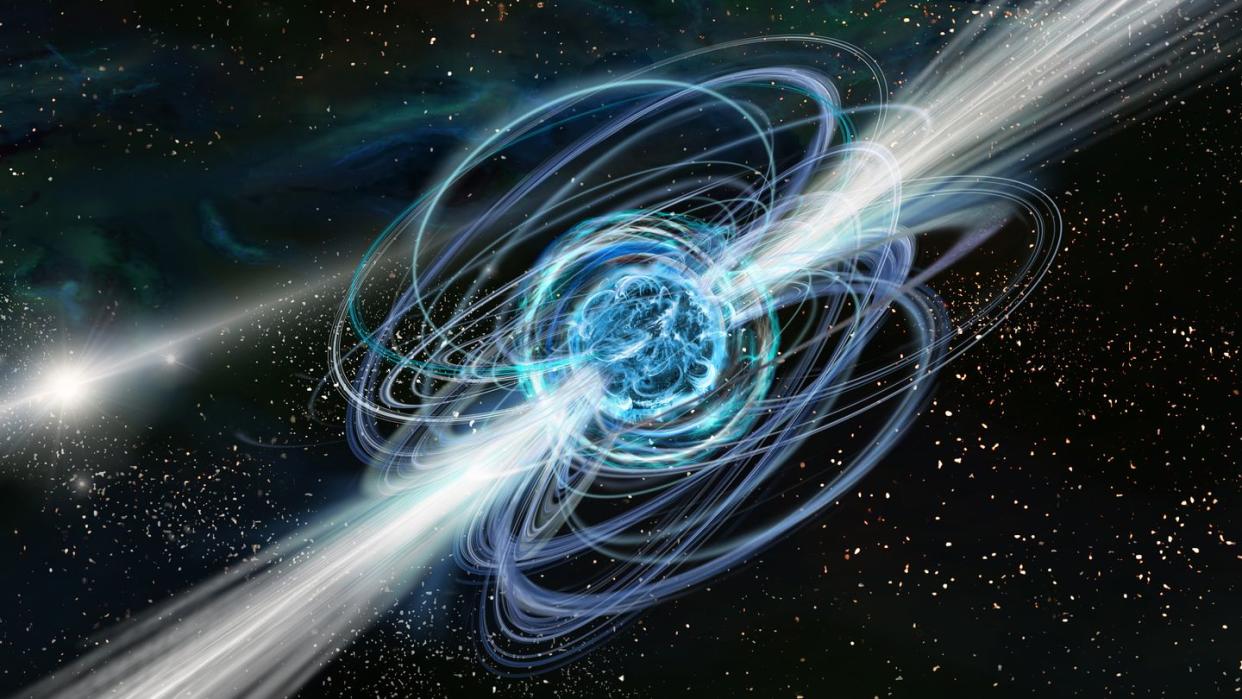Magnetars Are Even More Hardcore Than We Thought

Gamma ray bursts (GRBs) are created by some of the most intense objects in the universe—primarily, black holes.
But these high-energy bursts are also produced by magnetars, which are essentially highly magnetized neutron stars.
A new study suggests that the magnetars can create “relativistic blades” formed by magnetic winds that essentially bisect the star, creating some the brightest and longest-lasting GRBs ever recorded.
Magnetars are some of the most menacing celestial objects in the universe. Containing some of the most intense magnetic fields ever measured, these hyper-dense balls of matter are many times smaller than stars like our Sun, but shine many times brighter.
Now, a new study from the Center for Cosmology and Particle Physics at New York University claims that this kind of object could produce “relativistic blades”—formed by powerful outflows of plasma and magnetic winds—that essentially slice the magnetar in half. These blades could, in turn, produce some of the brightest gamma ray bursts (GRBs) ever recorded.
Gamma-ray bursts, or GRBs, are often associated with black holes, as the mind-bending physics of these objects produces the extreme energies necessary for GRB creation. However, magnetars—those highly magnetized neutron stars—are another major theoretical source for these high-energy emissions.
“Highly magnetized neutron stars as sources of classical gamma-ray bursts (GRBs) has been a topic spanning many decades,” the study, published on the preprint server arXiv, reads. “It is thought that with large enough surface magnetic fields and short spin-down times, magnetars can theoretically meet the extreme energy requirements necessary to power GRBs.”
In their paper, the scientists argue that this stellar self-mutilation could give magnetars the ability to produce ultra-bright gamma-ray bursts. These particular GRBs, they claim, form when a star collapses into a neutron star, which can then form into a magnetar through compression and rotation. This newborn magnetar can then pull in its remaining atmosphere and form a jet along its equator.
However, the new study suggests that not only do dying stars form this jet, but they also create a beam of plasma, referred to as a “lamina” or “blade,” across the star’s equator. This blade essentially bisects the magnetar with more energy than a supernova, according to Space.com.
Usually, GRBs are very far away and also very short, but this cosmic display of magnetar bisection could explain why some GRBs appear to linger longer than others. As this blade travels through the magnetar at nearly the speed of light, it picks up more material and causes continued instabilities in the star itself. Eventually, the blade travels many times the radius of the original star, which could explain why the GRBs last so long.
To further explore this mystery, the team says that they have to examine the timeline of these “relativistic blades” as well as exploring the many various nuances of a star’s death.
“We have demonstrated that an equatorial engine can produce an ultra-relativistic breakout focused into a very thin lamina structure,” the study says. “We also suggest that a detailed resolution study of relativistic jet breakout is needed to further pin down the limitations imposed by these compact GRB progenitors and seeding of turbulence.”
This is only further evidence that when a star collapses, almost anything goes.
You Might Also Like
